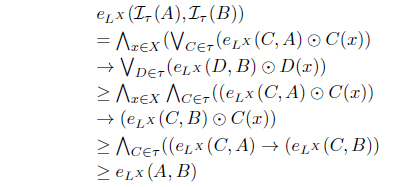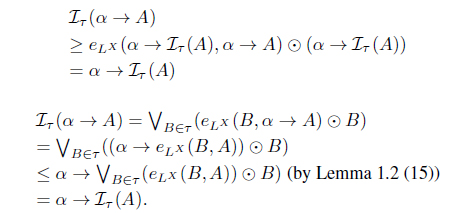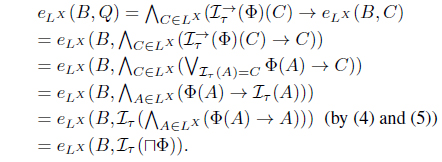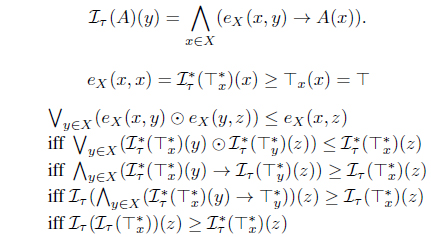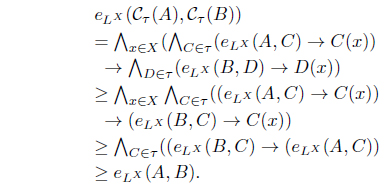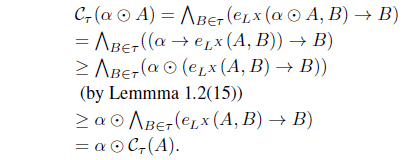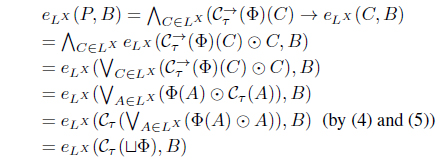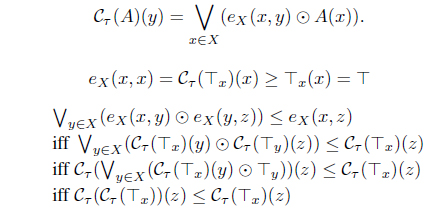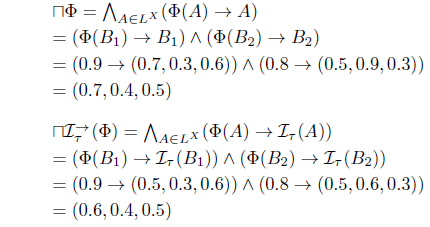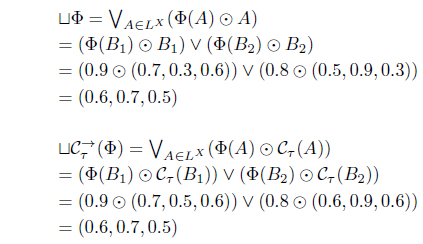



Pawlak [1, 2] introduced the rough set theory as a formal tool to deal with imprecision and uncertainty in the data analysis. Hájek [3] introduced a complete residuated lattice which is an algebraic structure for many valued logic. By using the concepts of lower and upper approximation operators, information systems and decision rules are investigated in complete residuated lattices [3-7]. Zhang and Fan [8] and Zhang et al. [9] introduced the fuzzy complete lattice which is defined by join and meet on fuzzy partially ordered sets. Alexandrov topologies [7, 10-12] were introduced the extensions of fuzzy topology and strong topology [13].
In this paper, we investigate the properties of Alexandrov topologies as the extensions of strong topologies and strong cotopologies in complete residuated lattices. Moreover, we study the notions as extensions of interior and closure operators. We give their examples.
Definition 1.1. [3, 4] An algebra (
(C1) L = (L, ≤, ∨, ∧, ⊥, 𝖳) is a complete lattice with the greatest element 𝖳 and the least element ⊥; (C2) (L, ⊙, 𝖳) is a commutative monoid; (C3) x ⊙ y ≤ z iff x ≤ y → z for x, y, z ∈ L.
In this paper, we assume (
Lemma 1.2. [3, 4] For each
(1) If y ≤ z, then x ⊙ y ≤ x ⊙ z. (2) If y ≤ z, then x → y ≤ x → z and z → x ≤ y → x. (3) x → y = 𝖳 iff x ≤ y. (4) x → 𝖳 = 𝖳 and 𝖳 → x = x. (5) x ⊙ y ≤ x ∧ y. (6). (7) and . (8) and . (9) (x → y) ⊙ x ≤ y and (y → z) ⊙ (x → y) ≤ (x → z). (10) x → y ≤ (y → z) → (x → z) and x → y ≤ (z → x) → (z → y). (11) and . (12) (x ⊙ y) → z = x → (y → z) = y → (x → z) and (x ⊙ y)∗ = x → y∗. (13) x∗ → y∗ = y → x and (x → y)∗ = x ⊙ y∗. (14) y → z ≤ x ⊙ y → x ⊙ z. (15) x → y ⊙ z ≥ (x → y) ⊙ z and (x → y) → z ≥ x ⊙ (y → z).
Definition 1.3. [7, 10, 12, 13] A subset
(T1) ⊥X, 𝖳X ∈ τ where 𝖳X(x) = 𝖳 and ⊥X(x) = ⊥ for x ∈ X. (T2) If Ai ∈ τ for i ∈ Γ, . (T3) α ⊙ A ∈ τ for all α ∈ L and A ∈ τ. (T4) α → A ∈ τ for all α ∈ L and A ∈ τ.
A subset
(ST) If
A subset
(SC) If
Remark 1.4. Each Alexandrov topology is both strong topology and strong cotopology.
Definition 1.5. [8, 9] Let
(E1) reflexive if eX (x, x) = 𝖳 for all x ∈ X, (E2) transitive if eX(x, y) ⊙ eX(y, z) ≤ eX(x, z), for all x, y, z ∈ X, (E3) if eX(x, y) = eX(y, x) = 𝖳, then x = y.
If
Example 1.6. (1) We define a function
(2) Let
Definition 1.7. [8, 9] Let (
(1) A point x0 is called a join of A, denoted by x0 = ⊔A if it satisfies (J1) A(x) ≤ eX(x, x0), (J2) . A point x1 is called a meet of A, denoted by x1 = ⊓A, if it satisfies (M1) A(x) ≤ eX(x1, x), (M2) .
Remark 1.8. [8, 9] Let (
(1) x0 is a join of A iff. (2) x1 is a meet of A iff . (3) If x0 is a join of A, then it is unique because eX(x0, y) = eX(y0, y) for all y ∈ X, put y = x0 or y = y0, then eX(x0, y0) = eX(y0, x0) = 𝖳 implies x0 = y0. Similarly, if a meet of A exist, then it is unique.
Remark 1.9. [8, 9] Let (
(1) Since then .(2) We have because
2. Some Properties of Alexandrov Topologies
Theorem 2.1. (1) A subset
(2)
Since
For each Φ :
(⇒) (T1) For Φ(
(T2) Let Φ(
(T3) Let Φ(
(2) Let
Theorem 2.2. Let
Then the following properties hold.
(1) eLX (A, B) ≤ eLX (Iτ (A), Iτ (B)), for A, B ∈ LX. (2) Iτ (A) ≤ A for all A ∈ LX. (3) Iτ (Iτ (A)) = Iτ (A) for all A ∈ LX. (4) Iτ (α → A) = α → Iτ (A) for all α ∈ L, A ∈ LX. (5) for all Ai ∈ LX. (6) for each Φ : L X → L where defined as . (7) . (8) Define τIτ = {A | A = Iτ (A)}. Then τ = τIτ . (9) There exists a fuzzy preorder eX : X × X → L such that
(2) Since
(3) Since
By (2),
(4) Since
(5) By (1), since
(6) For each Φ :
and from:
(7) . Since
Since
(8) It follows from
(9) Since , by (4) and (5), . Put . Then
Hence
Theorem 2.3. Let
Then the following properties hold.
(1) eLX (A, B) ≤ eLX (Cτ (A), Cτ (B)), for all A, B ∈ LX. (2) A ≤ Cτ (A) for all A ∈ LX. (3) Cτ (Cτ (A)) = Cτ (A) for all A ∈ LX. (4) Cτ (α ⊙ A) = α ⊙ Cτ (A) for all α ∈ L, A ∈ LX. (5) for all Ai ∈ LX. (6) for each Φ : LX → L where defined as . (7) . (8) Define τCτ = {A | A = Cτ (A)}. Then τ = τCτ. (9) (Cτ (A∗))∗ = Iτ∗ (A) for all A ∈ LX. (10) There exists a fuzzy preorder eX : X × X → L such that
(2) Since
(3) Since
(4) Since
(5) By (1), since
and
we have
(6) For each Φ :
and from:
(7) Put . Since
Since
(8) It follows from
(9)
(10) Since , by (4) and (5), . Put
Hence
Example 2.4. Let (
Let
(1) We define
where
(T1) For ⊥
(T2) For
Hence .
(T3) For
(T4) Since
Hence, for
(2) For
Iτ (B1) = (0.5, 0.3, 0.6), Iτ (B2) = (0.5, 0.6, 0.3), Cτ (B1) = (0.7, 0.5, 0.6), Cτ (B2) = (0.6, 0.9, 0.6).
Let Φ :
Thus, .
Thus, .
(3) We define
For
Since ⊓Φ = (0.7, 0.4, 0.5) and
we have .
Since ⊔Φ = (0.6, 0.7, 0.5) and
then .
The fuzzy complete lattice is defined with join and meet operators on fuzzy partially ordered sets. Alexandrov topologies are the extensions of fuzzy topology and strong topology.
Several properties of join and meet operators induced by Alexandrov topologies in complete residuated lattices have been elicited and proved. In addition, with the concepts of Zhang’s completeness, some extensions of interior and closure operators are investigated in the sense of Pawlak’s rough set theory on complete residuated lattices. It is expected to find some interesting functorial relationships between Alexandrov topologies and two operators.






